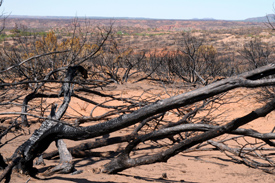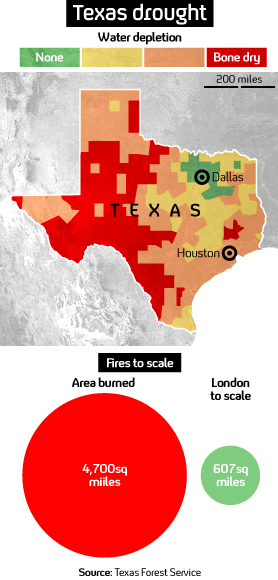Texas farmers hit by drought and wildfires
The US Government declares Texas a disaster area after a record drought and the state’s worst wildfire.

Texas has been suffering one of its longest dry periods, with some parts of the state receiving no rain since August 2010.
This, coupled with the wildfires blighting the southern United States, has put the state’s farmers and ranchers under intense pressure.
The US Agriculture Department designated 213 of Texas’s counties as disaster areas as a direct result of the drought – and then said the state’s remaining counties also qualify for aid because they are adjacent to disaster areas.
Thirty-two counties from other states in Louisiana, Oklahoma, Arkansas and New Mexico will also receive aid because they also border Texas’s disaster areas.
The drought and subsequent wildfires are due to an unusually severe La Nina weather pattern, which is a cooling of the tropical Pacific Ocean.
Less than half the usual rainfall fell in May – typically the state’s wettest month – and the lack of water has hit crop producers hard.
Over half of Texas’s cotton fields were in poor condition in June, according to the US Department of Agriculture, further boosting costs for textile manufacturers which include global brands such as Gap.

The harsh conditions mean Texas agriculture could sustain its worst single-year loss, potentially topping the 2006 record of $4.1bn.
US Agriculture Secretary Tom Vilsack pledged Obama’s support to farmers and ranchers.
“President Obama and I want these farmers and ranchers to know that we will support them through the recovery process and help them once again become productive suppliers of food, fibre and fuel that keep America prospering,” he said.
America has been suffering extreme weather patterns this year – with floods hitting much of the Midwest, tornados in Missouri and wildfires raging in New Mexico threatening the nuclear weapons complex at Los Alamos.
A hurricane warning for the east coast of Mexico has been downgraded in the face of Tropical Storm Arlene, which may result in some rainfall in southern Texas when it makes landfall.
Arelene’s water could provide some relief to drought-stricken areas, but scientists say the state really needs prolonged periods of steady precipitation to recover.
“Maybe some rain now can save parts of the irrigated area,” said Craig Heinrich, a Texas farmer. “For most of the area, it’s just too late.”